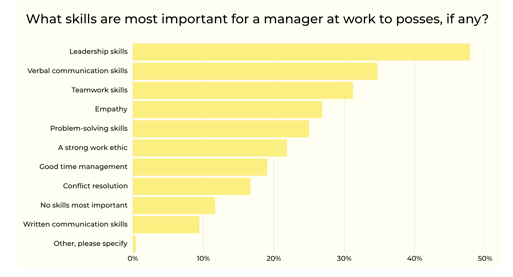Why Leadership Soft Skills Make All the Difference
The demand for professionals with a balance of soft skills is growing, particularly with the rise of AI. Leadership is a soft skill in and of itself - and it dovetails with many different interpersonal skills like communication, empathy and problem-solving.
You’ll need a solid mix of hard skills and soft skills to stand out and make an impact as a leader. As you move up, your role becomes less about “doing” and more about inspiring, aligning, and enabling others. This isn’t to say that managers and department heads don’t get stuck into day-to-day tasks, just that your role will probably shift to become more strategic.
When leading, poor communication, a lack of empathy, or an inability to resolve conflict can drain morale and drive away talented workers. The IT and Tech landscape is volatile, so leaders must be able to agile in response to challenges and uncertainty, all while guiding their colleagues.


Seven Leadership Soft Skills To Prioritise as a Tech Leader
There are many soft skills worth cultivating, but some matter more for aspiring leaders. Below is a curated list of seven priority leadership soft skills, why each matter and how you can grow them:
1. Communication and Active Listening
- Why it matters: Clear, consistent communication and listening is the foundation of trust. As a leader, how you listen to and respond to others is just as important as what you say to influence and inspire.
- How to grow it: Host or get involved with structured forums (like skip-level meetings, town halls and stand-ups) that allow you to receive feedback from a range of colleagues. Always be asking yourself and others “how can I communicate and listen better?”. You could also consider taking a business skills course.
2. Emotional Intelligence
- Why it matters: Emotional intelligence - including self-awareness, empathy and self-regulation - enables you to effectively and sensitively manage conflict. Colleagues will feel able to disclose issues, allowing you and your team to proactively solve problems as they occur.
- How to grow it: Use 360 feedback tools, keep a leadership journal, apply emotional regulation practices (pause, reflect, respond), or get in touch with a career coach who emphasises soft skills.
3. Strategic Thinking
- Why it matters: Senior leaders generally aren’t just task-oriented: they design strategies, set priorities, and align the team’s work with the overarching organisational vision and goals.
- How to grow it: Engage in scenario planning, join working groups or task forces, and use evaluative frameworks (OKRs, SWOT).
4. Time Management
- Why it matters: As a leader you’re balancing various workstreams, often whilst delegating tasks and setting priorities for the staff members you manage. Doing this effectively requires strong time management skills.
- How to grow it: Plan your days more efficiently with calendar blocking. Use project management software (such as Monday or Asana), and have regular check-ins with your colleagues to ensure that your tasks and goals properly align.
5. Resilience and Adaptability
- Why it matters: Remaining positive during times of uncertainty as a leader is key for team morale. Absorbing setbacks, approaching challenges with realistic and creative solutions and knowing when to pivot, are important for successfully guiding your team through change.
- How to grow it: Expose yourself to stretch assignments, reflect on setbacks for learning, adopt a growth mindset, and practice change leadership frameworks (e.g. ADKAR).
6. Coaching and Talent Development
- Why it matters: Your ability to mentor, coach and delegate is critical to long term business growth and impact, as you’re actively fostering the new generation of leaders.
- How to grow it: Complete a business skills course, hold regular 1:1s that cover training and development needs, and cultivate stretch opportunities for your team.
7. Judgement and Decision-Making
- Why it matters: As you move up, you’ll make high-leverage decisions that impact multiple areas of an organisation. Good judgement - exercised with balancing data and intuition - is vital.
- How to grow it: Use decision frameworks, perform After Action Reviews (AAR), simulate tradeoff decisions, and gather feedback from colleagues of all levels on your decision process.
There are numerous complementary soft skills that are invaluable for leaders - but the ones above, in my experience, tend to drive the biggest leadership lift.
Fact: 74% of UK Tech Firms Now Prioritise Soft Skills Over Hard Skills When Hiring
Out of the many industries surveyed earlier this year by Startups, the Technology and Software sector came out on top as most favouring soft skills over hard skills when hiring.
Notably, across all sectors, 64% of employers are prioritising soft skills over hard skills in 2025.
When progressing in your Tech career, investment in soft skills isn’t optional: it’s a strategic necessity.

How to Develop Leadership Soft Skills - Six Practical Steps
Developing soft skills isn’t a one-off: it’s a continuous journey that requires deliberate focus. Below are steps myself and the senior leadership team at Learning People often advise our students who are upskilling to take:
1. Assess and Identify Your Baseline
-
Use feedback from multiple sources (such as peers, direct reports, managers) to identify your soft skill gaps. You can do this by completing a personal skills audit.
-
Compare feedback with your intentions - often there’s a blind spot. For example, your communication may feel clear to you but come across as opaque to others.
2. Set Specific, Measurable Goals
-
For example, instead of “I want to be more empathetic”, aim for “In weekly 1:1s, I will ask two open questions and summarise the speaker’s point of view before responding.”
-
Review goals quarterly - the Tech sector moves quickly and so your goals need to as well.
3. Practice in Safe Contexts
-
Take leadership of small initiatives or cross-team tasks as “safe labs” for experimentation. This works especially well if you’re still in the early stages of your career.
-
Volunteer for internal initiatives, mentoring, or task groups to diversify your influence.
4. Learn via Training, Coaching and Peer Learning
-
Attend industry events, lectures and webinars.
-
Speak to a career advisor or mentor.
-
Share challenges and role-play with peers - hold each other accountable.
5. Reflect, Adjust, Repeat
-
After presentations, conflict resolution and 1:1s, debrief: what went well? What could I do differently?
-
Record your reflections in a leadership journal or log.
-
Always ask for feedback and be sure to apply it.
6. Track Progress Over Time
-
Regularly (annually, every quarter etc) create anonymous surveys so that colleagues can comfortably and confidently provide feedback.
-
Monitor retention and team engagement metrics where possible. Identify causes of low morale and work to counter and prevent them.
Fact: Managers Who Incorporate Soft Skills Can Increase Team Performance by as much as 30%
Latest research by the National Soft Skills Foundation suggests that applying soft skills in leadership (such as communication, coaching and listening) can improve team performance by almost a third.
Soft skills and power skills enable better communication and collaboration in the workplace.

Leadership Soft Skills - Final Thoughts
Moving into senior leadership doesn’t happen through technical mastery alone: you need to show how you can effectively and confidently influence, empower, and steward a diverse team.
The leadership soft skills we’ve covered - communication, emotional intelligence, strategic thinking, influence, resilience, coaching, decision making and more, - are among the highest-leverage abilities you can cultivate.
Because soft skills evolve slowly, start early and build momentum. Use feedback, safe stretch assignments, coaching, peer learning, and reflection to develop them. Over time, the difference will be night and day: you’ll become a more trusted, effective, resilient leader with stronger career prospects.




